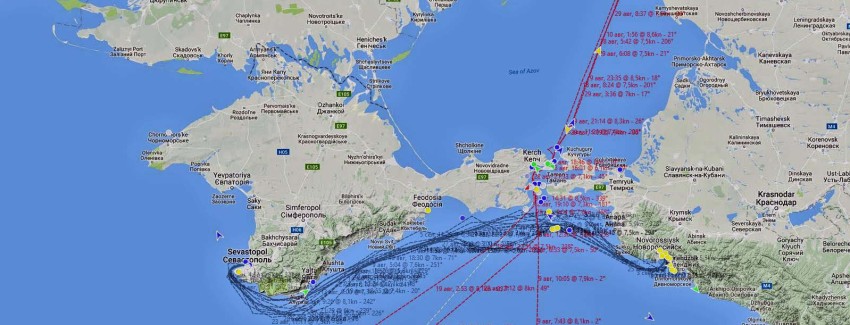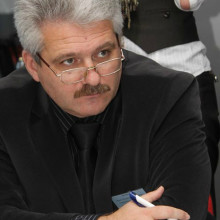Andriy Klymenko
Maidan of Foreign Affairs’ expert,
Chief Editor BSNews
Introduction
Before the occupation of Crimea, sea transport has not been vital neither for public nor for freight transportation of the peninsula. The bulk of passengers and cargo to and from Crimea was being carried by trains and cars from the mainland Ukraine, or by planes via Simferopol airport.
Until 2014 the most important parts of sea traffic in Crimea were:
- Sea cruises to Yalta and Sevastopol
- Marine grain export from Sevastopol and Kerch terminals
- Marine petroleum export from Feodosia processing facility
- Marine liquid gas re-export from Kerch terminals
- Marine import of different trade goods from Turkey by regular ferry lines from Zonguldak to Eupatoria (consumer goods) and from Zonguldak to Sevastopol (new cars)
After Russian occupation and annexation of Crimea, gradual decrease of overland shipments from the mainland started. By the end of December 2014, rail service has stopped completely. In October-November 2015 Ukraine completely suspended cargo traffic to Crimea. Simultaneously one more important railway was blocked – the one which connected Kherson region to “Crimean Titan” plant, the major manufacturer of titanium dioxide and mineral fertilizers, which were also purposed for export. Thereby the role of sea transportation for the occupied peninsula changed greatly.
In circumstances of total inland blockade of Crimea – and until the completion of Kerch Strait Bridge project by the end of 2018 and 2019 (road link and rail link respectively), sea transportation has already become uniquely and extremely important for Crimean passenger transportation and goods supply.
Since the first days of occupation, sea routes have the same exclusive importance for the military transportation, as well: particularly for transporting military units, vehicles and equipment to the occupied lands, necessary in context of peninsula’s militarization and turning it into a major military base.
There are 10 seaports on the territory of occupied Crimean peninsula. Eight of them, including seven state-owned and 1 privately owned, belong to the Autonomous Republic of Crimea:
- Chernomorsk Seaport (specialized facility of Chernomorneftegaz concern, located in the Chernomorskoye, north-west of the peninsula)
- Eupatoria Trading port
- Yalta Trading port
- Feodosia Trading port (which includes the specialized dock of Feodosia oil tank farm)
- Kerch Trading port
- Kerch Fishing Port
- “Crimea Port” – Kerch Strait Ferry Crossing
- Kamysh-Burun Port located in Kerch (former part of liquidated iron ore plant,later – private port of Altcom company)
In the city of Sevastopol, there are two seaports:
- Sevastopol Trading port
- Sevastopol Fishing Port
Note, that fishing ports in Kerch and Sevastopol has lost their specialization long ago and now they provide services for whole variety of vessels.
Sanctions
On March 27, 2014, the 80th plenary meeting of the United Nations General Assembly adopted Resolution 68/262 entitled "Territorial integrity of Ukraine". In it, General Assembly underscored the invalidity of the 2014 Crimean Referendum and called upon all the States, international organizations and specialized agencies “…not to recognize any alteration of the status of the Autonomous Republic of Crimea and the city of Sevastopol on the basis of the above-mentioned referendum and to refrain from any action or dealing that might be interpreted as recognizing any such altered status”.
Note: International Maritime Organization, IMO is an international intergovernmental organization; it is a special agency of the United Nations, which serves as means for cooperation and information exchange in technical questions on the international shipping.
On April 27th the Law of Ukraine “On Securing the Rights and Freedoms of Citizens and the Legal Regime on the Temporarily Occupied Territory of Ukraine” came into force. Until today, this law remains the main legal document of Ukraine concerning various aspects appearing after occupation and the annexation of Crimea and Sevastopol. Transportation included.
While adopting this law, an article #332-1 was supplemented to Criminal Code of Ukraine. According to this article, the crewmembers of vessel, arriving to Crimea, fall under administrative and criminal liability in Ukraine for the illegal group border crossing and violation of the procedures of entry into the occupied territory.
Article 332-1. Violating the Procedure of Entry in the Temporarily Occupied Territory or Exit Therefrom
1. Violating the procedure of entry in the temporarily occupied territory of Ukraine and exit therefrom, committed with the aim of causing damage to interests of the state – shall be punishable by restriction of liberty for a term of up to three years or by imprisonment for the same term, with forfeiture of vehicles.
2. The same actions, if committed repeatedly or by a group of people in prior conspiracy, or by an official person using his or her official position – shall be punishable by imprisonment for a term of three to five years, as well as debarment from holding certain office or engaging in certain activity for a term of up to three years, and with forfeiture of vehicles. 12
3. Actions provided for by clauses one or two of this Article, if committed by an organized group – shall be punishable by imprisonment for a term of five to eight years, as well as debarment from holding certain office or engaging in certain activity for a term of up to three years, and with forfeiture of vehicles."
Pursuant to the law “On Securing the Rights and Freedoms of Citizens and the Legal Regime on the Temporarily Occupied Territory of Ukraine”, on April 30th 2014 the government of Ukraine endorsed a prescript “On the temporary closure of border checkpoints and control points”.
Prescript #424-p, issued on April 30th 2014, “On the temporary closure of border checkpoints and control points” http://www.kmu.gov.ua/control/uk/cardnpd?docid=247263828
This decision closed, in particular, border checkpoints, located at the Crimean peninsula seaports, including those at the territories of businesses with sea docks. With the same document, the government of Ukraine gave to Ministry of Foreign Affairs a commission to bring to the notice of the diplomatic offices of foreign states in Ukraine, the diplomatic missions and consular offices of Ukraine the information about temporary closure of the state border checkpoints and control points.
Besides, on June 16 2014 the Ministry of Infrastructure of Ukraine announced the closure of seaports at the Crimean peninsula and gave this information to international organizations concerned.
http://zakon3.rada.gov.ua/laws/show/z0690-14
Later, European Union, USA, Canada, Australia, New Zealand and some other countries made the number of decisions on applying sanctions against Russia because of the occupation and annexation of Crimea. In the field of maritime transport, these decisions forbid: vessels entering ports in the Crimea (Autonomous Republic of Crimea and Sevastopol), exporting and importing products and services from its territory, including insurance, investments, etc.
General results of vessels monitoring
In this report, we present “the black list” of naval vessels that entered ports of occupied Crimea by August 15th 2016 . Monitoring group of “Maidan of Foreign Affairs” Fund and editorial office of BlackSeaNews.net keep these observations since March 18th 2014, the date of annexation of Crimea, concerning sea vessels, which visited 9 of 10 Crimean ports: in Eupatoria, Sevastopol (2 ports), Yalta, Feodosia, Kerch (4 ports).
Note. We do not publish the results of monitoring over the vessels entering Chernomorsk port, because all of them are parts of technological fleet of Ukrainian State concern Chernomornaftogaz. All state assets of this enterprise, including gas deposits and fleet (drilling platforms, offshore supply vessels, tugs, etc.) were “nationalized” – in fact expropriated – and became war trophies of the occupants. Other vessels do not enter this port. Separate research about Chernomornaftogaz fleet will be published.
This monitoring concerns only naval vessels that conduct passenger and cargo shipments in/out seaports of Crimean peninsula, also specialized vessels taking part in realization of major infrastructural projects of occupation authorities (dredgers, cable layers, pipe layers, etc.)
Monitoring method
- We do not consider violators and do not include to this “black list” the following:
- Port fleet vessels (passenger boats, tugs, floating cranes, dredging vessels, garbage boats) assigned to Crimean ports. They are state property of Ukraine and were “nationalized” – in fact, they are war trophies of occupants.
- Vessels - no matter under which flag – which by the moment of occupation happened to stay under repair on Crimean shipbuilding and ship-repairing facilities or were on halt in Crimean seaports.
- Yachts staying in Crimean yacht clubs when occupation began.
- Fishing fleet belonging to various Crimean owners.
- Only dates of arriving to ports are shown in the monitoring tables/ Usually after arrival vessels stay in port for several days – for loading or unloading.
- Vessel’s flag is often not similar to vessel’s owner (the owner state) and moreover is not similar to vessel’s management (the state of vessel operator) because it changes often;
- There are certain difficulties while registering ship-owners and ship-operators, because actual owners from the “black list”, especially foreign ones, excluding Russia, are trying to avoid sanctions and actively use re-registration of vessels to fictitious owners; also, they regularly change operating companies.
- The data on vessel flag is actual as of August 15 2016.
- We do not count in the vessels, which were identified by Automatic Identification System (AIS) as arriving to Crimean seaports, but which actually were on anchor off the coast just waiting the storm weather to pass.
- To confirm the fact of vessels arriving to Crimean seaports we use data of several AIS-services, because they operate with different information arrays (for example, the vessel shown on one of services may not be seen on another). The main source of monitoring is Ukrainian sea resource www.shippingexplorer.net.
- The monitoring is conducted on everyday basis, several times a day, since March 18 2014, the date of Crimean occupation by Russia, holidays included.
From March 18 2014 till August 15 2016, 260 commercial vessels flying the flags of 32 states got into the “black list” for visiting seaports of occupied Crimea in violation of prohibitions and sanctions. The data on vessel flag is actual as of August 15 2016.
One should consider, that during the Crimean occupation 60 of 260 commercial vessels arriving to Crimean seaports – it is 23% –by different reasons have changed the flags under which they got to the “black list” in 2014-2015. This process is separately depicted below.
The number and the net weight of vessels violating the Legal Regime on the Occupied Territory of Crimea by state flags as of August 15 2016
|
# |
Flag |
Vessels |
% |
# |
Flag |
Vessels |
% |
|
1 |
Russia |
139 |
53,3 |
17 |
Greece |
2 |
0,8 |
|
2 |
Togo |
19 |
7,3 |
18 |
Korea |
2 |
0,8 |
|
3 |
Panama |
11 |
4,2 |
19 |
Singapore |
2 |
0,8 |
|
4 |
Comoros |
9 |
3,5 |
20 |
Sri Lanka |
2 |
0,8 |
|
5 |
Palau |
8 |
3,1 |
21 |
Vanuatu |
2 |
0,8 |
|
6 |
Sierra Leone |
7 |
2,7 |
22 |
Antigua & Barbuda |
1 |
0,4 |
|
7 |
Tanzania |
7 |
2,7 |
23 |
Cambodia |
1 |
0,4 |
|
8 |
Mongolia |
6 |
2,3 |
24 |
Cayman Is |
1 |
0,4 |
|
9 |
Saint Kitts & Nevis |
6 |
2,3 |
25 |
China |
1 |
0,4 |
|
10 |
Belize |
5 |
1,9 |
26 |
Cook Is |
1 |
0,4 |
|
11 |
Malta |
5 |
1,9 |
27 |
Cyprus |
1 |
0,4 |
|
12 |
Moldova |
5 |
1,9 |
28 |
Italy |
1 |
0,4 |
|
13 |
Turkey |
4 |
1,5 |
29 |
Liberia |
1 |
0,4 |
|
14 |
Bulgaria |
3 |
1,2 |
30 |
Portugal |
1 |
0,4 |
|
15 |
Marshall Islands |
3 |
1,2 |
31 |
Saint Vincent & Grenadines |
1 |
0,4 |
|
16 |
DR Congo |
2 |
0,8 |
32 |
Tuvalu |
1 |
0,4 |
|
Total = 260 |
|||||||
139 of these 260 vessels (53,3%) as of August 15 2016 were registered under Russian flag, the flag of occupant state. On the second place are vessels under Togo flag – 19 (7,3%), the third place hold the vessels under flag of Panama – 11 (4,2 %)
Next in the rating are vessels flying flags of following states: Comoros – 9 (3,5%); Palau - 8 (3,%); Sierra Leone - 7 (2,7%); Tanzania - 7 (2,7%); Mongolia - 6 (2,3%); Saint Kitts & Nevis - 6 (2,3%), Belize - 5 (1,9%). 8 of violating vessels which got to the “black list” were registered under flags of EU states: 5 from Malta and 3 from Bulgaria (NATO member). 5 vessels were registered under Moldavian flag (Agreement of Association with EU). 4 vessels were flying Turkish flag (NATO member)
The number and the net weight of vessels violating the Legal Regime on the Occupied Territory of Crimea by state flags from March 18 2014 till August 15 2016
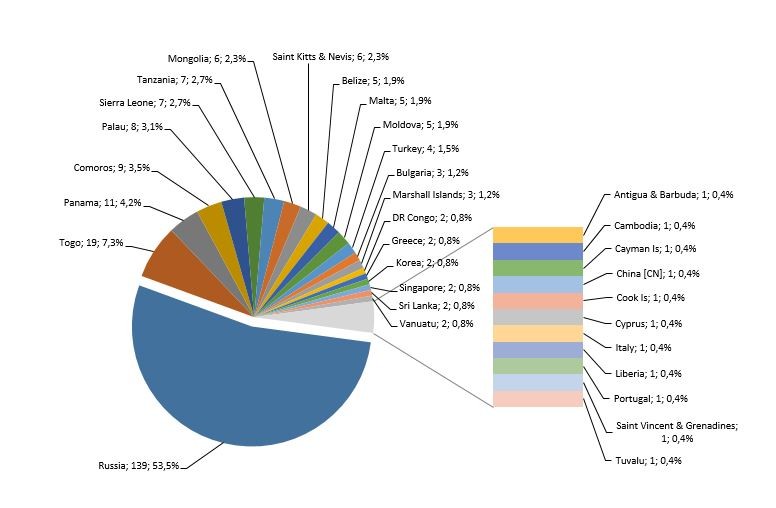
However, this kind of analysis does not describe the total picture in dynamics. So, let us consider the situation in development.
In 2014 (since March 18) 146 vessels arrived to Crimean seaports, 66 of them (45,2%) were flying Russian flag. In 2015 172 vessels entered Crimean seaports, and net weight of violating vessels under Russian flag has grown considerably – 108 (62,8%). As of August 15 2016, in less than 8 months, 126 vessels arrived to Crimean seaports, and the share of violators under Russian flag exceeded 70% - 89 vessels, 70,6%.
It clearly illustrates the ongoing process of gradual replacement of foreign commercial vessels by Russian ones, arriving to Crimea. It is the direct consequence of Ukrainian bans, international sanctions and “black lists” published in Ukrainian press and republished in specialized naval media abroad.
The number and the net weight of vessels violating the Legal Regime
on the Occupied Territory of Crimea by state flags
from March 18 2014 till August 15 2016 by years
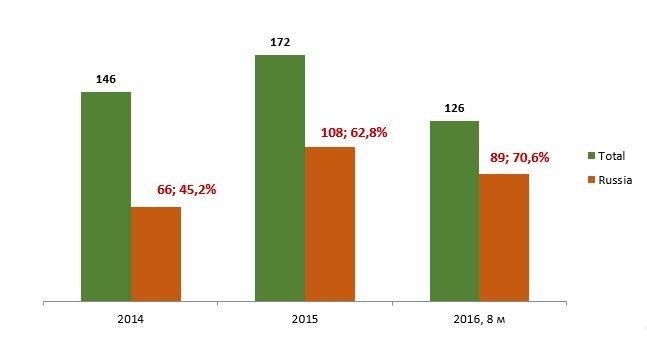
Note, that actual number of violating vessels belonging to Russian owners exceeds 70%, for some of them are registered under flags of other states (separate analysis will follow).
Listed total number of violating vessels from the “black list” does not mean that all of these 260 ships continue to ply to Crimea during all these 2,5 years. Actually, this process looks different. On the diagram below all the violating vessels are grouped like this:
- Vessels which visited Crimea only in 2014 – there were 63 of these (under Russian flag – just 16 or 25,4%)
- Vessels which visited Crimea only during first two years of occupation, 2014 and 2015– just 29 of these, including 10 or 34,5% under Russian flag
- Vessels which visited Crimea only in 2015 – there were 42, including 24 or 50% under Russian flag
- Vessels which visited Crimea in 2015 and 2016 – there were 54, under Russian flag there were 37 or 68,5%
- “Regulars” - vessels that visited Crimea during all the period of occupation – 2014, 2015 and 2016. There were 47 of these, 37 of them, or 78,7% under Russian flag
- A small group of vessels, which returned to Crimea after one year – in other words they visited peninsula in 2014 and in 2016, but not in 2015. There were 7 of these, 3 of them, or 42,8% under Russian flag.
- Newbies violators, which started to appear in Crimean seaports only in 2016 – just 18 of them, including 12 or 66,7% under Russian flag.
The fact that only 18 new vessels appeared among the violators in 8 months of 2016, and that only seven violators from 2014 returned to Crimean routes, shows the appearance of more or less permanent “Crimean merchant fleet”.
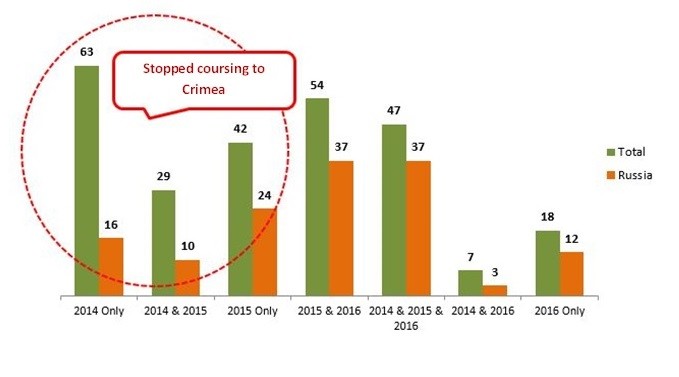
By 2016 more than a half of 260 vessels of so-called “Crimean merchant fleet” enlisted in the “black list” – 134 (51,5%), including 50 vessels flying Russian flag – stopped working for Crimean seaports. As of August 15 2016 there are 126 vessels in the “black list” of fully operational “Crimean merchant fleet”, including 89 (70,6%) under Russian flag.
This situation is the result of many factors, including Ukrainian and international sanctions; on the other hand it illustrates the level of respect or disrespect of governmental bodies (flag administrations) of certain states regarding UN and EU decisions. In the tables below the activities of vessels from different states, coursing to the occupied Crimea linked to the fact how these state voted at the 80th plenary meeting of United Nations General Assembly on March 27 2014, resolution in question - 68/262 "Territorial integrity of Ukraine".
By August 15 2016, trade vessels from of 14 states of 32 identified in 2014-2015 continue coursing to occupied Crimea.
Among them, two vessels under the flag of EU and NATO member, Bulgaria, which belong to subsidiary of Russian “Lukoil” (gas tankers). 11 vessels under Togo flag, 5 – under Mongolian, 4 under Tanzanian, the rest are single cases under flags of China, Moldova and various offshore islands.
Official delegations of five stated among 14 enlisted below, voted in favor the mentioned resolution.
The number of vessels violating the Legal Regime on the Occupied Territory of Crimea which continue to enter Crimean seaports in 2016, by state flags
|
№ |
Flag / Year |
2015 & 2016 |
2014 & 2015 & 2016 |
2014 & 2016 |
2016 Only |
Total |
UN vote 27.03.14 |
|
1 |
Belize |
1 |
1 |
No vote |
|||
|
2 |
Bulgaria |
2 |
2 |
Yes |
|||
|
3 |
China |
1 |
1 |
Abstain |
|||
|
4 |
Comoros |
2 |
1 |
3 |
Abstain |
||
|
5 |
Cook Is |
1 |
1 |
- |
|||
|
6 |
Moldova |
1 |
1 |
2 |
Yes |
||
|
7 |
Mongolia |
1 |
4 |
5 |
Abstain |
||
|
8 |
Palau |
2 |
2 |
Yes |
|||
|
9 |
Panama |
1 |
1 |
2 |
Yes |
||
|
10 |
Russia |
37 |
37 |
3 |
11 |
88 |
No |
|
11 |
Saint Kitts & Nevis |
1 |
1 |
Abstain |
|||
|
12 |
Sierra Leone |
1 |
1 |
2 |
Yes |
||
|
13 |
Tanzania |
1 |
2 |
1 |
4 |
Abstain |
|
|
14 |
Togo |
5 |
3 |
2 |
1 |
11 |
Yes |
By 2016 trade vessels under flags of 18 states stopped coming to occupied Crimea. 11 of them voted in favor of mentioned UN resolution. Besides, 11 of 18 states, including EU members Italy and Malta, has removed vessels under their flags from the Crimean ports back in 2014.
The number of vessels violating the Legal Regime on the Occupied Territory of Crimea, which stopped to come to Crimean seaports in 2016, by state flags
|
|
Flag / Year |
2014 Only |
2014 & 2015 |
2015 Only |
Total |
UN vote 27.03.14 |
|
1 |
Antigua & Barbuda |
1 |
1 |
Abstain |
||
|
2 |
Cambodia |
1 |
1 |
Abstain |
||
|
3 |
Cayman Is |
1 |
1 |
- |
||
|
4 |
DR Congo |
2 |
2 |
Yes |
||
|
5 |
Cyprus |
1 |
1 |
Yes |
||
|
6 |
Greece |
1 |
1 |
2 |
Yes |
|
|
7 |
Italy |
1 |
1 |
Yes |
||
|
8 |
Korea |
2 |
2 |
Yes |
||
|
9 |
Liberia |
1 |
1 |
Yes |
||
|
10 |
Malta |
5 |
5 |
Yes |
||
|
11 |
Marshall Islands |
3 |
3 |
Yes |
||
|
12 |
Portugal |
1 |
1 |
Yes |
||
|
13 |
Saint Vincent & Grenadines |
1 |
1 |
Abstain |
||
|
14 |
Singapore |
1 |
1 |
2 |
Yes |
|
|
15 |
Sri Lanka |
2 |
2 |
Abstain |
||
|
16 |
Turkey |
3 |
|
1 |
|
Yes |
|
17 |
Tuvalu |
1 |
1 |
No vote |
||
|
18 |
Vanuatu |
1 |
1 |
2 |
No vote |
None of this means that all the vessels under the flags of countries listed above stopped coming to Crimea at all. Part of them re-registered under flags of other countries to be able to continue visiting Crimean seaports (see Change of Flags chapter). Nevertheless, we can claim that UN decision on March 27 2014 continues to influence shipping in the occupied Crimea.
Violator vessels analysis by types
The major group of vessels, violating the legal regime on the occupied territory of Crimea, consists of bulk carriers shipping general cargo. There are 129 of them, nearly half of total (49,6%). One third of total number of violator vessels are tankers, 86 of them (33,1%). Inside this group, we can distinguish the special subgroup of gas carriers, which ship liquefied natural gas to Turkey from the terminal located in the Kerch Trading Port – there are 20 of them (23,3% of tankers). That is one of a few export positions for sea transport in Crimea.
Liquefied natural gas in railroad cisterns comes by railroad ferries from Russia to Kerch Fishing Port, there at the special terminal it is transferred to special tankers (gas-carriers).
Particular group of violator vessels consists of ferries. During the monitoring period there were identified 31 of them (11,9 of total number). Most of them work for Kerch Strait Crossing and other ferry-lines between Russia and occupied Crimea (details in Ferries chapter).
The number and the net weight of vessels violating the Legal Regime
on the Occupied Territory of Crimea by main types
from March 18 2014 till August 15 2016

General Cargo
Among the 129 violating bulk carriers during the monitoring period, there is a trend for growing net weight of vessels under Russian flag. It is not as obvious as for other vessel types though.
The number and the net weight of General Cargo violating the Legal Regime
on the Occupied Territory of Crimea by main types
from March 18 2014 till August 15 2016 (by years)
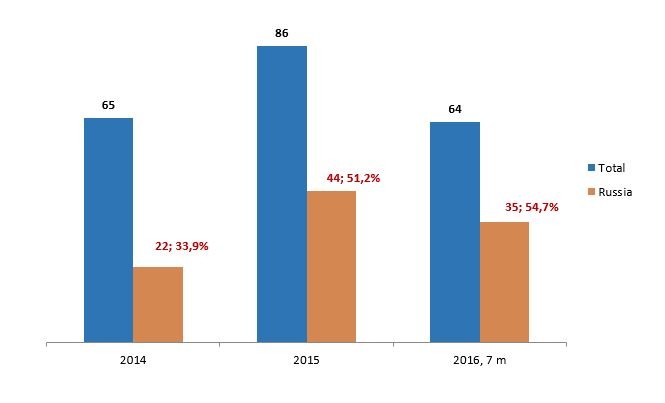
In case of General Cargo, we see the majority of changing flags cases (except for Russia) – mainly it is about Togo and Tanzania.
The number of General Cargo violating the Legal Regime on the Occupied Territory of Crimea, which continue to come to Crimea in 2016 (by state flags)
|
Flag |
2015 & 2016 |
2014 & 2015 & 2016 |
2014 & 2016 |
2016 Only |
Total |
|
|
|
|
|
|
|
|
Comoros |
2 |
1 |
3 |
||
|
Cook Is |
1 |
1 |
|||
|
Moldova |
1 |
1 |
2 |
||
|
Mongolia |
1 |
1 |
|||
|
Palau |
2 |
2 |
|||
|
Panama |
1 |
1 |
2 |
||
|
Russia |
18 |
12 |
5 |
35 |
|
|
Saint Kitts & Nevis |
1 |
1 |
|||
|
Sierra Leone |
1 |
1 |
2 |
||
|
Tanzania |
1 |
2 |
1 |
4 |
|
|
Togo |
5 |
3 |
2 |
1 |
11 |
|
|
|
|
|
|
|
|
Total |
30 |
19 |
4 |
11 |
64 |
The relatively big share of foreign (except for Russia) General Cargo in the “black list” can be explained by specifics of exports form Crimea in violation of international sanctions.
The main export goods for General Cargo:
- Grain to ports of Syria, Northern Cyprus, Lebanon, Libya, Egypt – no less than 12 bulk carriers identified.
- Scrap metal to ports of Turkey and Romania – no less than 8 bulk carriers
Tankers
Among the 86 violating tankers during the monitoring period, there is a trend, similar for all vessel types, for growing net weight of vessels under Russian flag.
Note. In the Tanker chapter, we include also 9 sea vessels of Nefterudovoz type. It is a hybrid dry and liquid cargo vessel fit for rivers and sea. Built in a Soviet period and capable of shipping both petroleum products and dry cargo (the type of the vessel in sea databases - Ore/oil Carrier, Obo Carrier)
Excluding 20 gas carriers, in 2015 and 2016 only vessels flying Russian flag came to Crimean ports. Oil tankers under foreign flags (except for Russia) which came to Crimean ports in 2014 after the occupation – has left the Crimean destination.
The only tanker under the foreign flag (except for Russia) which worked with Crimean ports in 2015-2016 – belongs to Russian owner.
|
Flag: Belize Vessel type: Former name(s): |
IMO: 9155248 Build year: 1997 |
Home port: Belize City |
Sevastopol: 25.02 - 20.06.15 - Kerch: 2016 – operates between the raid berth in the Kerch Strait and the marina located to the south. |
The number and the net weight of tankers violating the Legal Regime
on the Occupied Territory of Crimea by main types
from March 18 2014 till August 15 2016 (by years)
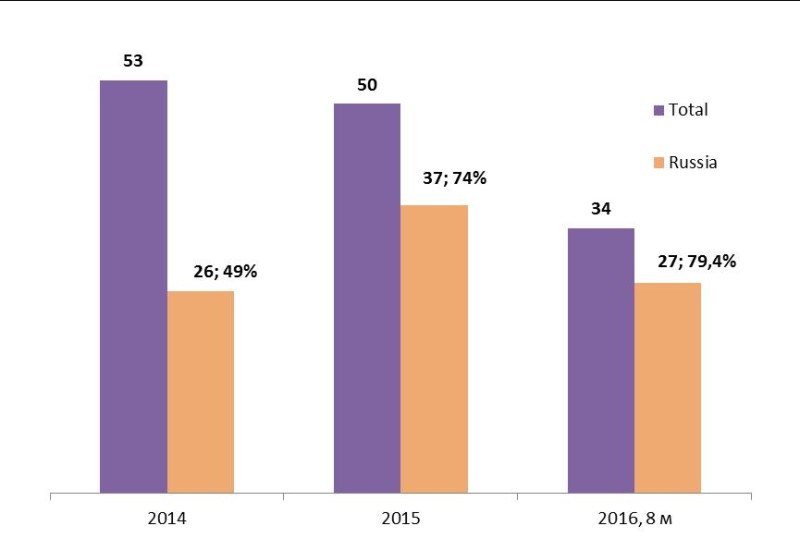
Oil tankers are used to deliver petroleum products to oil depots, located at all ports of the occupied Crimea, including main oil processing facility of Black Sea Fleet in Sevastopol and the biggest in Crimea oil processing facility in Feodosia. The latter, unlike before the occupation, is used to gather and store petroleum products for internal needs of the peninsula, which are delivered from Novorossiysk or across the Azov Sea from Temruk and Rostov-on-Don ports.
Sea export of petroleum products from Crimea through Feodosia Oil Depot has stopped after the occupation. Before, petroleum products were exported from this depot to different countries, getting to the place by railroad and later being re-pumped to big tankers.
LPG-tankers continue shipments (re-export) of liquefied petroleum gas from the only LPG terminal in Kerch Fishing Port.
Note. LPG is a mix of light hydrocarbon gases liquefied under high pressure. It can be used as fuel or as a raw material for organic synthesis. The main components are propane and butane.
The terminal makes transshipment of transit liquefied hydrocarbon gases from rail cisterns to storage facilities and after that to LPG tankers. Liquefied gas comes from Russia and Kazakhstan in rail cisterns and by ferries through the Kerch Strait.
The number of foreign gas tankers violating the Legal Regime
on the Occupied Territory of Crimea by main types
from March 18 2014 till August 15 2016 (by years)
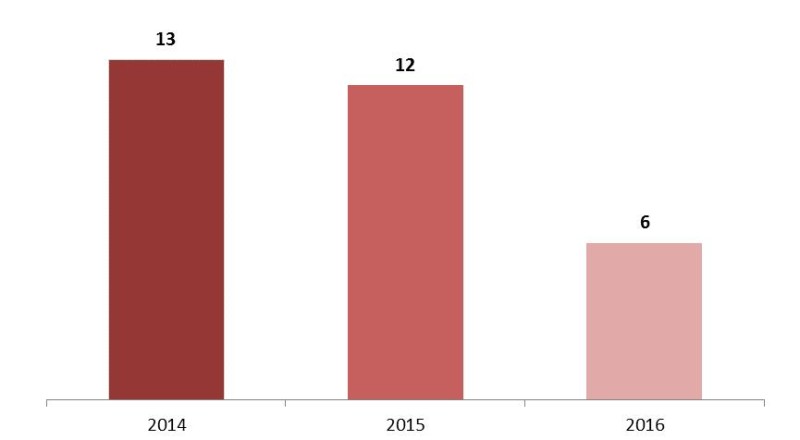
LPG tankers are among the most persistent violators of the legal regime on the occupied territories and of the international sanctions. Most of them made several dozens of calls to occupied Crimea. However as we can see from the monitoring data, the number of violating tankers tend to decrease.
Because of sanctions and publishing of the “black lists” in media with following republishing abroad, 8 gas tankers in 2014 and 5 more in 2015 has stopped entering gas terminal at the Kerch Fishing Port.
Most of them were transferred to other regions or switched to deliveries of liquefied gas from Russian ports of Temruk and Taman. Six of these tankers has changed name and/or flag (See Change of the Flag chapter).
In general, the number of LPG-tankers entering Kerch terminal has shortened because of fear of sanctions. It has led to slowing of activities at the Kerch gas terminal, the main activities switched to Russian ports of Temruk and Taman.
At the same time, there are some sort of “champions” among the gas tankers, which continue exporting liquefied gas from the occupied Crimea. At the moment of sanctions violating they belonged to the Turkish owner:
|
METAL (TALA) New Name: ALTERA 1 New Flag: Mongolia Vessel type: |
IMO: 8012114 Gross tonnage: 5,165 tons Build year: 1982 |
Class society: Overseas Marine Certification Services Owner: Hdl Partners Owner and Manager: Milenyum Denizcilik Gemi, Nazli Sokak 9, Halilrifatpasa Mah, Sisli, 34384, Istanbul, Turkey Owner: Vinista Shipping - Peru |
Kerch: 29.08.14 Gas cargo from the Kerch sea fishing port to Turkey and Lebanon. |
|
MARIANA New Name: MARIA New Flag: Mongolia New MMSI: 457294000 Vessel type: |
IMO: 8016835 Gross tonnage: 2,314 tons. Summer DWT: 1,665 tons Build year: 1982 |
Home port: Freetown Owner and Manager: Milenyum Denizcilik Gemi, Nazli Sokak 9, Halilrifatpasa Mah, Sisli, 34384, Istanbul, Turkey, Website unavailable, TBC. |
Kerch: Since April 2014, 1-2 trips per month with the liquified gas cargo to the Turkish terminal at the Marmara Eregli port. No less than 15 trips in 2015, the latest of which on: 20.06.15 Instead of Kerch, specifies destination with the AIS as the Black Sea. All in all, over 30 calls at Kerch. |
Ferries
Ferry connection between the ports of occupied Crimea, Russia and Turkey has become much more important after the occupation, than it was before February 2014.
Passenger and cargo shipments via the Kerch Strait Crossing “Crimea Port – Caucasus Port” were insignificant before the occupation, mostly regional – between Autonomous Republic of Crimea and Krasnodarskiy Kray of Russian Federation. Ferries were transporting passengers on cars, passengers on buses, commercial vehicles. Passenger rail service across the Kerch Strait (train Sevastopol – Sverdlovsk) does not function since the end of 1980th, freight rail service shut down in 1996.
Until 2014, two Ukrainian ferries - “Yeysk” and “Kerchenskiy-2”, provided the functioning of ferry crossing which transported passengers and vehicles. Those ferries belonged to Ukrainian state-owned shipping company “Kerch Ferry Crossing”.
YEYSK: IMO: 8725565, Build year: 1988, Builder: Riga Shipyard - Riga, Latvia. Gross tonnage: 1,028 tons. Summer DWT: 254 tons. Capacity – 160 passengers, 25 cars / 16 trucks (up to 7,5 tonnes). 4 round trips per day.
KERCHENSKIY-2: IMO: 7741017. Build year: 1978. Builder: Riga Shipyard - Riga, Latvia. Gross tonnage: 1,022 tons. Summer DWT: 382 tons. Capacity: 215 passengers, cars up to 4,2 meters long - 27, full-size buses - 4. 4 round trips per day.
Since December 2013 one more ferry was added: car & passenger “Nikolay Aksyonenko”, rebuilt freighter (vessel owner – russian shipping company “Anship”, “Anusstrans” group).
NIKOLAY AKSENENKO: IMO: 9711250. Build year: 2013. Builder: Sevmorverf. Gross tonnage: 1,421 tons. Summer DWT: 331 tons. Capaciry – 261 passenger, 43 cars / 4 trucks. 4 round trips per day
Railroad freight service through the Kerch Strait was reestablished at the end of 2004. Two similar-type Russian rail ferries worked at the crossing, belonging to “Anrusstrans” group – “Annenkov” and “Petrovsk” (rebuilt of “Slavutych”-type freighters).
ANNENKOV: IMO: 8841450. Build year: 1984. Builder: Kiev Shipbuilding & Ship repair Yard. Gross tonnage: 3,083 tons. Summer DWT: 3,170 tons. Length: 112 m. Beam: 16 m. Bearing capacity: 2852 т. Holding capacity – 25 railroad cars. 4 round trips per day.
PETROVSK: IMO: 8841474. Build year: 1986. Builder: Kiev Shipbuilding & Ship repair Yard. Gross tonnage: 3,083 tons. Summer DWT: 3,170 tons. Length: 112 m. Beam: 16 m. Bearing capacity: 2852 т. Holding capacity – 25 railroad cars. 4 round trips per day.
Besides of Kerch Strait Crossing, before the occupation there functioned cargo-and-passenger ferry lines Eupatoria – Zonguldak (truck transportation) and Sevastopol-Zonguldak (mostly new cars transportation).
After the occupation, ferry-shipments became the main part of sea shipments to Crimea. Number of ferries increased drastically, new ferry lines opened to other destinations, in addition to Ferry Port “Crimea”, as its capacity of docking, and parking facilities and other infrastructure could not match increasing demand and still cannot even after the reconstruction.
In 2014 after the occupation the following ferry crossings functioned in Crimea:
- Kerch Ferry Crossing “Port Caucasus – Port Crimea” (cargo-and-passenger and railroad)
- Port Caucasus – Kerch Trading Port ( freight and cars)
- Port Caucasus – Kerch Fishing Port (Freight and cars)
- Temruk – Kerch Trading Port (freight and cars)
- Novorossiysk – Feodosia (freight and cars) – functioned only in 2014
- Novorossiysk – Sevastopol (freight and cars) – replaced by container ferry since September 2013
- Zonguldak – Sevastopol (freight and cars) – functioned till the end of 2015.
- Zonguldak – Eupatoria (freight and car) – functioned till the end of 2015.
- Samsun – Kerch (freight and cars) – turned out to be inefficient and was closed in 2014.
The beginning of strait lines operations back in 2014 was characterized by chaotic involvement of private operators under various flags.
Since 2015 docks at Kerch strait crossing and ports were reconstructed and most of the assorted car ferries coursing between port Caucasus and Kerch were replaced by new GLYKOFILOUSA type of ferries constructed in Greece, which had larger capacity. Gradually Russian owners bought out those ferries and re-registered them under Russian flag.
In total, during the occupation there were 31 ferries working on Crimean destination. By now 21 of them continue working, most of them registered (re-registered) under Russian flag.
The number of ferries violating the Legal Regime on the Occupied Territory
of Crimea by main types from March 18 2014 till August 15 2016 (by years)
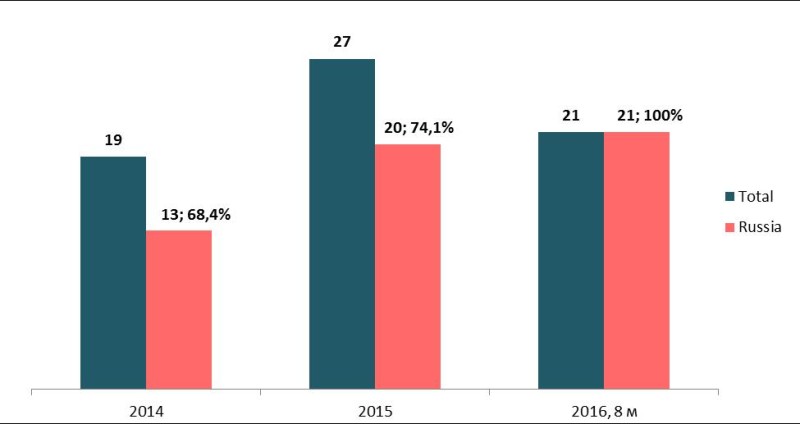
Cruise liners
Before the annexation Crimean seaport had been successfully developing as international passenger terminals. In 2013 Yalta seaport served 109 cruise liners (apart from “river-sea” vessels) and 77880 passengers; Sevastopol seaport - 58 liners and 23400 passengers. , Feodosia seaport – 18 liners and 3479 passengers, Eupatoria and Kerch seaports served one cruise liner each.
After the occupation, cruise liners stopped visiting Crimean seaport almost completely back in 2014, except for several cases. New projects of Russian cruise operators were abandoned before starting or shortly after initiating.
Among reasons for that were not only Ukrainian and international sanctions but also great response in the media after two foreign cruise liners arrived to occupied Yalta in 2014.
In 2013 co-owners and management of Russian ferry operator “St.Peter Line” have founded Russian company “Paradise Cruise and Ferry”. For that purpose at the end of 2013 they bought passenger ferry Poseidon Express from Finnish company Finnlines. Flag: Belize, IMO: 8706040.After the Crimean occupation ship-owner refused to work over the cruise program. Instead since 01.05.14 till 24.07.14 that ferry has been worknig on cargo-and-passenger line Novorossiysk – Feodosia, and by September 2014 has left Black Sea for good.
On September 17th 2014 Grecian cruise liner Ocean Majesty flying Portugal flag and chartered by German company Hansa Touristik GmbH, arrived from Sochi port to occupied Yalta. Moreover, they raised Russian guest flag, which meant both owner and operator of the vessel recognized the annexation of Crimea. After this story appeared in media, the lined cancelled planned visit to Odessa in fear of arrest.
Since May 30 2014 till the middle of June 2013 a small cruise liner Adriana under St.Kitts and Nevis flag cruised by route Sochi – Novorossiysk – Istanbul – Yalta – Sochi, which meant it arrived to Istanbul from Russian territory and based at the Black Sea since May 2013. The vessel belongs to Russian ship-owner. Formally, the owners are Tropicana Cruises Ltd (Cuba) and Adriana Shipping Ltd (Caribbean), though the final owner is Sergei Ponyatovskiy, the figure well known in Russian cruise business.
For these trips Russian company Black & Baltic Sea Cruise chartered the liner. The company was subsidiary of Russian Tour Operator “Expo-Tour”, St. Petersburg, and made cruises “Five Black Sea Vacation Capitals”. Later these cruises had been cancelled and cruise operator went broke.
Since July 16 till October 25 2014 cruise liner Adriana made 14 cruises from Zeitinburnu port in Marmara Sea (Istanbul) to occupied and annexed Sevastopol, thus violating sanctioning regime adopted by number of states and international organization after the annexation of Crimea. Passengers of the vessel were mainly so called shuttle-traders.
Since October 25 2014 till the spring of 2015 this vessel was under repair in occupied Sevastopol – it was maintained at the shipyard in Kanyshovaya Bay. Adriana announced to start cruises from Crimea to Turkey since April 15; later the start date was delayed until the beginning of May. So-called Crimean Ministry of Tourism even announced the cruise schedule.
However, on April 23 2015 the liner left Sevastopol and went to Caribbean Sea. The reason for that was denial of Turkish administration to approve cruises to occupied Crimea – after media, civil society, Crimean tartars and Ukrainian diplomats harshly criticized the idea.
On May 3rd and 17th 2016, Russian river cruise liner “Velikaya Rus” arrived from Samara to occupied Kerch, carrying 196 passengers. Vessel-owner is “Express-Tour” company, Russia, Perm.
Analysis of violating vessels by ports of arrival to occupied Crimea
Cargo turnover of the main Ukrainian seaports in Crimea in 2013 was: Sevastopol Trade Port - 4801,2 thousand tons, Kerch Port - 2791,5 thousand tons, Feodosia - 2601,8 thousand tons, Eupatoria - 976,9 thousand tons, Yalta - 162,2 thousand tons. Comparing to pre-occupation period, a significant redistribution in loading of the Crimean ports happened, as well as a fundamental change in their role and importance. In this situation the natural leadership in number of trading vessels, coming to ports, went over to Kerch facilities altogether (Kerch Trade Port, Kerch Fishing Port, Kerch Strait Crossing and Kerch “Kamysh-Burun” seaport). Sevastopol seaports have lost their leadership in cargo turnover because of losing the main part of export (before the occupation large amounts of grain and metal were exported from Sevastopol).
Cargo turnover dynamics of main Crimean seaports (millions of tons)
in 2012 – 2015
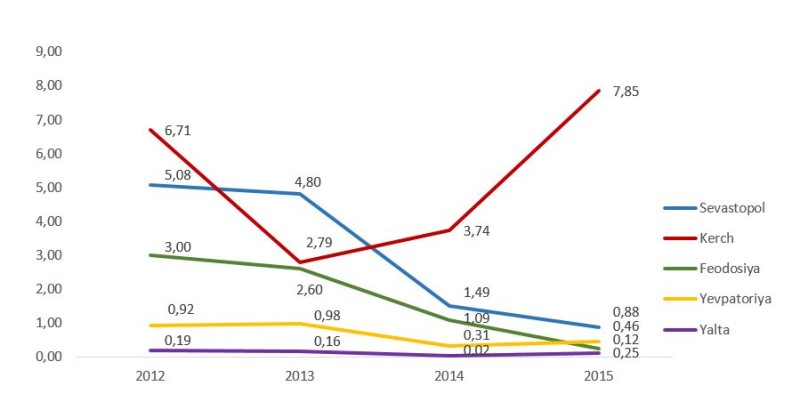
In 2,5 years to Kerch arrived 171, to Sevastopol – 142, to Feodosia – 71, to Yalta – 26 and to Eupatoria – 5 of total 260 violating vessels (significant part of them visited more than one Crimean port).
Total degradation of Eupatoria and Yalta seaports happened after the occupation. Now these ports in fact are not functioning.
Inefficiency of ferry transportation through Feodosia changed Feodosia oil tank farm main purpose from exporting to storing facility and increased oil supplies deliveries by railroad through Kerch Strait lead to further degrading of Feodosia seaport.
Comparative analysis of violating vessels by ports of arrival
from 18.03.14 till 15.08.16
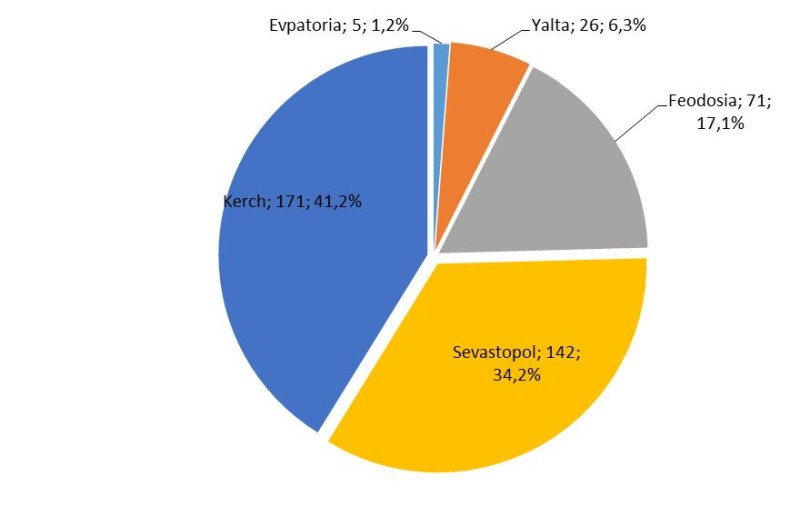
From the very beginning, the occupational authorities of Crimea and Sevastopol adopted the strategy of expropriation and changing ports management by merging facilities.
On March 17 2014 by resolution of “State Council of the Republic of Crimea” #1757-6/14 all the Ukrainian enterprises and assets in the field of sea transportation were “nationalized” and went into the ownership of “Republic of Crimea”.
On March 2014 by resolution of “State Council of the Republic of Crimea” #1865-6/14 Republican state enterprise ”Crimean Seaports” was founded. It included as subsidiaries Kerch Trade Port, Kerch Fishing Port, Feodosia Trade Port, Yalta Trade Port, Evpatoria Trade Port.
The same day state enterprise “Crimean Sea Transport” was founded (resolution of “State Council of the Republic of Crimea” #1832-6/14 adopted on 26.03.2014). It included Kerch, Feodosia, Yalta, Eupatoria branches of state enterprise “Administration of Seaports of Ukraine”; Kerch Maritime Rescue & Coordination sub-center of the branch "Marine search and rescue service" of state enterprise "Administration of Seaports of Ukraine"; "Gosgidrografiya" state agency in Kerch region; Kerch State Marine Technological University.
Besides, state enterprise “State Shipment Company “Kerch Ferry Crossing” owned by “Republic of Crimea” was founded based on Ukrainian state-owned shipment company “Kerch Ferry Crossing” (resolution of “State Council of the Republic of Crimea” #1866-6/14 adopted on 26.03.2014). State enterprise “Lotsman-Crimea” was created based on property of Azov-Crimea regional administration of “Delta-Lotsman” branch of state enterprise "Administration of Seaports of Ukraine" (resolution of “State Council of the Republic of Crimea” #1867-6/14 adopted on 26.03.2014).
On March 27 2014 by resolution #17 (7178) “Sevastopol Legislative Assembly” founded “Sevastopol Seaport” based on property of Sevastopol Trade Port and Sevastopol Fishing Port.
On June 2 2014, resolution of “Sevastopol administration” # 29 “On founding of National Unitarian Enterprise “Sevastopol Seaport” was adopted. New enterprise included Sevastopol Trade Port, Sevastopol Fishing Port, Captain Service of Sevastopol Fishing Port and Sevastopol branch of state agency “Gosgidrografiya”.
Merger of all seaports of Crimea AR into one legal entity led to the situation when seaports of Eupatoria, Yalta and Feodosia are financed by incomes generated by Kerch Strait Crossing and Kerch ports.
Repairs and the age of vessels
During the monitoring period 50 of 260 violator vessels (19,23%) identified in Crimean ports, got repairs of various duration at the shipyards of occupied Crimea.
24 vessels repaired at Sevastopol shipyards, 26 – at Kerch shipyards. 43 of 50 vessels (86%) were registered under Russian flag.
This situation can be explained by old age of vessels, hastily gathered from different Russian shipping companies to provide them to Crimea.
The newest vessels, built most recently, are mainly Greek ferries and some Russian tankers. The age of 63% of vessels, mainly bulk carriers, is between 27 and 60 years, in particular: 14 vessels (10%) – 47-60 years, 34 vessels (26%) – 37-46 years, 36 vessels (37%) – 27-36 years.
Stratification of violating vessels registered under Russian flag by age
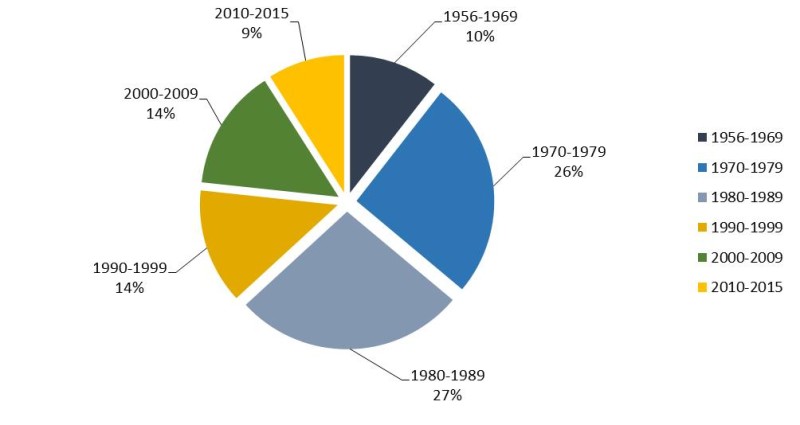
Change of flags
During the occupation period 60 merchant vessels have changed flags under which they got into the “black list” in 2014 – 2015 (in most cases they changed names and owners as well). The reasons for that may vary, so let us consider some examples.
EU countries (Greece, Malta, Italy, Cyprus)
Since 2014 till today 6 Greek ferries, which came to work at the Kerch Strait crossing under Greek flag, changed their registration to Russian flag. On more ferry that started operating in Kerch Strait under flag of Cyprus also changed the state of registration to Russia.
Greek owners sold all of those seven ferries to Russian companies. Thus, they have made a significant contribution to providing transportation of passengers and goods, including Russian troops and military equipment from inland Russia to occupied Crimea. Among the new ferry owners, there is a specialized enterprise belonging to Russian Defense Ministry – “Oboronologistika”.
On January 20 2016, the head of the Russian government Dmitry Medvedev signed the resolution that defines “Oboronologistika” as the only supplier of personnel and munitions ferry logistic services for Russian Defense Ministry – acting in the Republic of Crimea and Kaliningrad region. The fleet of “Oboronologistika” at the Kerch Strait consists of ex-Greek ferries “Maria” and ”Laurentiy”.
“Koksohimtrans” LLC is one more operator of formerly Greek ferries at the Kerch Strait Crossing.
The fleet of company consists of 3 vessels: freight ferry “Aleksandr Tkachenko” (formerly Italian ROBUR), car-and-passenger ferries “Major Cipichev” and “Elena”. The last purchase is “Elena” ferry, bought on June 2016 by leasing company “LK-Capital” to give it into financial leasing to “Koksohimtrans” LLC. The deal was financed by “Russia” bank. The deal amounted to more than 500 mln. rubles.
Greek Ferries that changed Greek flag to Russian one
|
AGIOS LAVRENTIOS New Name: LAVRENTIY New Flag: Russia News MMSI: 273387810 Vessel type: |
IMO: 8647866 Gross tonnage: 989 tons. Length: 100 m Build year: 2010 Вместимость – 500 пассажиров, до 24 грузовых а/м. Количество кругорейсов в сутки – 7. |
Home port: Athens Owner & Manager: Koinopraxia Epivatochimatagogon Salaminos - Paloukia, Greece New owner: Registered Owner: Owner: Operator – Agenstvo “Gruzovyie Linii” On April 4, 2014, RF Ministry of Transport has issued the Oboronlogistics the license for transporting dangerous cargo by sea and domestic water transport. |
Kerch: 15.06.15 – arrived. 10.07.15-present -- began servicing the Port Caucasus – Kerch Fishing Port line (carried cargo transport, including that with dangerous cargo). Also transports troops. |
|
MARIA ELENI New Name: MARIA New Flag: Russia Vessel type: |
IMO: 9617923 Gross tonnage: 998 tons. Length: 105 m Вместимость – 500 пассажиров, до 24 грузовых а/м. Количество кругорейсов в сутки – 7. |
Home port: Athens Owner & Manager: Agios Nikolaos Salamina Shipping - Salamis Island, Greece New owner: Registered owner: Smart Way LLC, Address: Russia, 105062 Moscow, Furmannyy pereulok, d. 12, str. 1. Email: ruslan@smartway-line.ru; kolyadasv@mail.ru
Owner: 115172, Russia, Moscow, Goncharnaya 28, section 2. Теl: Operator – Agenstvo “Gruzovyie Linii”
On April 4, 2014, the RF Ministry of Transport has issued the Oboronlogistics the license for transporting dangerous cargo by the sea and domestic water transport. On 20.01.16, Prime-Minister of the RF D.Medvedev signed the regulation on making Oboronlogistics the exclusive provider of services to the RF Mnistry of Defense on carrying troops and military cargo in the Republic of Crimea and Kalinigrad oblast. |
Kerch: 15.06.15 - arrival 02.07.15 -- began servicing the Port Caucasus – Kerch Fishing port line (carried cargo transport, including that with dangerous cargo). Also transports troops. |
|
PROTOPOROS VI New Name: POBEDA New Flag: Russia Vessel type: |
IMO: 9657222 Year Built: 2012 |
Home port: Athens Owner & Manager: Evoikos Vi Maritime - Eretria, Greece Charterer – Proekt, RF. Capacity – 500 passangers and 150 cars. 7 daily roundtrips. |
Kerch: 19.05.15 – arrival to Kerch. 22.05-02.06.15 - retrofitting at the Zaliv shipyard. 04.06.15 - present regular service of the Port Crimea – Port Caucasus ferry line. |
|
New Name: MAJOR CHAPICHEV New Flag: Russia Vessel type: |
IMO: 9554638 Gross tonnage: 987 tons Build year: 2008 |
Home port: Athens Owner: Agios Nikolaos Salamina Shipping - Salamis Island, Greece New owner – Sovfrakht, Russia Capacity – 500 passangers and 160 cars or 18 cargo trucks. 12 daily roundtrips.
|
Kerch: 27.05.15 -- arrival 10.06.15 -- services the Port Caucasus-Kerch Merchant Seaport ferry line (carried cargo transport, including that with dangerous cargo) |
|
New Flag: Russia Vessel type: |
IMO: 9688611 |
Home port: Athens Owner: Evoikos Iv Maritime - Eretria, Greece Charterer – Vart and K, RF. Capacity – 500 passangers and 150 cars. 12 daily roundtrips. |
Kerch: 09.05.15 – arrived to Kerch where has undergone customs procedures and change of flag. 16.05.15–present -- regular service on the Port Crimea–Port Caucasus ferry line. |
|
ELENA Flag: Russia Vessel Type: Ro-Ro Passenger |
IMO: 9774501 Length overall (LOA): 102.2 m Gross Tonnage: - Deadweight: - Length Overall x Breadth Extreme: 102m × 18m Year Built: - |
Owner: – Sovfrakht Capacity – 540 passangers, 140 cars/ 20 cargo trucks. 12 roundtrips daily.
Kryminform from August 8:.Rossiya Bank has acted as the financing bank on the purchase of the Yelena passenger and cargo ferry Yelena for service on the Kerch ferry line. The information came today from the bank’s press-service.
Rossiya Bank has financed the leasing deal on acquiring the Yelena passenger ferry by the Koksokhimtrans. The amount of the transaction was over 500 mln rubles, – mentioned the press-service and pointed out that the 2015 ferry with the 510 passanger and 140 car capacity, had already started servicing the Kerch Strait ferry line.
Koksokhimtrans – is a leading freight forwarding company working in Crimea. The company fleet includes: cargo ferry Alexander Tkachenko and the car/passenger ferries Major Chapichev and Yelena. Паром
Yelena ferry was purchased by the LK-Kapital leasing company for financial leasing to финансовый лизинг Koksokhimtrans |
A new ferry on the Kerch ferry line. On 09.06.16 left the Greek port of Salamin. Arrived to the Kerch shipyard on 18.06.16. Started operation on 07.07.16 |
One of the first Greek ferries arrived to Kerch Strait Crossing back in July 2014 flying Cyprus flag. It operated under that flag until the beginning of 2015, and then was bought by Russian owner.
|
OLYMPIADA New Flag: Russia Vessel type: Ro-ro/passenger Ship Former name(s): |
IMO: 8611532 Gross tonnage: 918 tons. Summer DWT: 1,291 tons. Length: 195 m. Beam: 15 m Build year: 1989. Builder: North East Shipbuilders - Sunderland, U.k. |
Class society: Registro Italiano Navale. Owner: Dorieus Maritime New owner: Proekt. Charterer: Sea Directory, RF. Capacity – 600 passengers and 120 cars or 16 cargo trucks. 7 roundtrips daily. |
Kerch: 16.07.14 - 2015 - present services the Port Crimea – Port Caucasus ferry line. Around January 2015 has changed flag to the RF. Has been sold to a Russia ship owner.
Sevastopol: |
Italian ROBUR ferry has also started operating at Crimean destination under Italian flag in July 2014, three months after the occupation. It transported cargo from Temruk to Kerch.
In October 2014, this ferry went back to Italy because its crew was protesting and afraid to get under sanctions. At the beginning of 2014, Italian owner has sold this ferry to Russian buyer, so the vessel changed flag to Russian and came back operating on Temruk – Kerch route. Since September 2015, this ferry was chartered by Russian Ministry of Defense to make deliveries of military freights to Syria. It made no less than 5 trips from Novorossiysk to Tartus.
|
ROBUR New Flag: Russia New MMSI: 273376430 Vessel type: Ro-ro Cargo Former name(s): Caribbean Dignity (2008 Sep). Robur (2006 Mar) |
IMO: 8716954. Gross tonnage: 7,067 tons. Summer DWT: 3,966 tons. Length: 125 m. Beam: 20 m. Draught: 4.4 m. Build year: 1989. Builder: Cantieri Navali Visentini - Porto Viro, Italy. Home port: Bari. Class society: Registro Italiano Navale |
Owner: Visentini Giovanni Transporti - Milano, Italy, Manager: Strand Management - Athens, Greece. Адрес: 33, Akti Miaouli, 185 35 Piraeus, Greece Now: CMP-Leasing, Address: Russia, 115035 Moscow, Sadovnicheskaya 71, Bldg 3. СМТ Crimea (Sovfrakht-Sovmortrans group), RF Purchased by the СМТ Crimea from an Italian shipowner who had stopped operation to Crimea due to sanctions. Renamed “Alexander Tkachenko”. Since September 2015, chartered by the RF Ministry of Defense for carrying military cargo to Syria. Has made no less than 5 trips. |
Kerch: 04.07 - 27.09.14: 18.10.14 – left the Black Sea 13.01.15 -- returned Since 06.03.15 – again on the Temryuk-Kerch- Feofosiya line: Sevastopol: |
Italian LPG-tanker SYN MAIA regularly came to occupied Crimea until the middle of 2015. After the “black list” as of July 12 2015 was published, this vessel stopped coming to Crimean ports. It transports LPG from Temruk. At the beginning of 2016 has changed its flag from Italy to Panama, probably owner has changed too.
|
SYN MAIA From 2016-03-03: New Name: New Flag: Panama New MMSI: 374713000 Vessel type: Former name(s): |
IMO: 9003079 Gross tonnage: 3,983 tons Build year: 1993 |
Home port: Augusta Owner: Synergas - Napoli, Italy |
Kerch: 26.04.14 Since the 12.07.2015 black list publication, has stopped calling at the Crimean ports, carries liquefied gas from Тemryuk. |
Two vessels at the ports of occupied Crimea identified under Maltese flag have changed registration by different reasons. MINTANK ONE tanker was sold and went to Southeast Asia. GOODNESS bulk carrier, which belonged to Turkish owner, had to be re-registered to be able to work in Crimea without risk of getting under EU sanctions.
|
MINTANK ONE New Name: New Flag: Korea Vessel type: Oil/chemical Tanker |
IMO: 9310214 Gross tonnage: 3,982 tons. Summer DWT: 5,695 tons. Length: 103 m. Beam: 16 m Build year: 2005 |
Home port: Valletta Owner & Manager: |
Feodosia: 12.07.14 In October 2014 changed the region of operation, the flag and the owner, presumably for a Korean one. |
|
GOODNESS New Name: New Flag: Togo New MMSI: 671666000 Vessel type: General Cargo В декабре 2015 сменил название и флаг Former name(s): |
IMO: 8116180 Gross tonnage: 3,134 tons. Summer DWT: 3,960 tons Build year: 1983 |
Home port: Valletta Owner: Manager: Most probably has changed the owner. |
Kerch: 30.07.14 |
Other countries
Six vessels abandoned Panama flag. In most cases, the reason for that was the desire of owners to keep coming to Crimea without getting in trouble.
- 4 of them re-registered under Mongolian flag; these are LPG-tankers belonging to Turkish owner. They have changed their names and kept transporting Russian liquefied gas to Turkey from the Kerch Fishing Port terminal. Entering Kerch Strait, they just switch off the AIS transmitter (see below).
- 1 is bulk carrier belonging to Russian ship owner. It has changed flag to Russian and kept coming to Crimea.
- 1 is bulk carrier belonging to Greek ship owner. It has changed flag to Belize, took another name and another region of operations. Since January 2015, it has stopped coming to Crimea.
Six vessels abandoned Turkish flag. In most cases, it happened because they were sold to Russian owners.
- 1 vessel re-registered under Russian flag; it was Turkish bulk carrier ALICAN DEVAL, today it became military convoy of Russian Black Sea Navy “DVINITSA-50” (IMO: 7500578), in July 2014 was identified while loading grain at “Avlita” terminal in occupied Sevastopol, cargo bound to Iskenderun, Turkey. In 2015, the vessel was bought out from Turkish Deval Shipping & Trading Company, Turkey. At early fall 2013 it was included into 205 regiment of supply convoys of Russian Black Sea Navy. Currently used to supply Russian military forces in Syria.
- 1 vessel re-registered under Cayman Islands flag. It is mega-yacht EGERIA (IMO: 8662610), it visited occupied Crimea in August 2014. Since, the vessel not only has changed the flag, it also changed its name twice. Never came to Black Sea after that.
- 1 vessel re-registered under Panamanian flag. It is Turkish tanker KAZAN (new name NAZAN, IMO: 9373747), came to occupied Crimea in July and August 2014. Never visited Crimean ports in last two years.
- 3 vessels re-registered under flag of Palau. All those vessels are Turkish ferries, urgently bought or chartered by Russian companies immediately after the occupation of the Crimea. Two of them were bought by “Karadeniz Logistics” LLC, Novorossiysk (NOVOROSSIYSK, former ULUSOY 1, and SEVASTOPOL, former ULUSOY 2). They operated in Novorossiysk – Feodosia and Novorossiysk – Kerch routes.
In May 2015, these vessels suddenly left the routes and by the end of 2015, they were arrested for stopping paying wages to the crew. Today they are docked in Sevastopol and Novorossiysk and are to be sold to cover debts. The third ferry, YUSUF ZIYA ONIS, later RAINBOW, today AZOV – since August 2015 operates on route Tripoli (Lebanon) – Duba (Saudi Arabia)
5 vessels abandoned Moldovan flag. Probably, the position of Moldovan flag administration played its role here. In 2015, Moldovan authorities sent warning to all registered vessels, reminding it was forbidden to come to occupied ports of Crimea.
- 2 vessels changed their flags to Russian. Those vessels actively operate in Crimean seaports since the beginning of the occupation. They belong to the companies, registered or re-registered at the occupied territory. They are bulk carrier TASE (IMO: 8857978) and tanker TEC I (New Name: ALEXANDER NEVSKIY), IMO: 9648685.
- 2 vessels changed their flags to Comoros, but by totally different reasons. Greek bulk carrier STELLA DI MARE has been seen under Moldovan flag only once – in occupied Sevastopol in August 2014. After that if was transferred to other region with the new flag. Turkish bulk carrier DENIZ (IMO: 7361635) keeps actively visiting Crimean ports under Comorian flag, as it did before under flag of Moldova.
4 vessels abandoned Cambodian flag. Of 4 vessels primarily identified and enlisted to “black list” under flag of Cambodia, two by now have shifted to Togo flag, one to Russian and one to Mongolian. Vessels under Russian and Mongolian flags continued to come to Crimea in 2016 (see below).
Going under the flag of Mongolia
If in 2014 there were no Mongolian flags flying over the violating vessels in Crimean ports, by now group of five Turkish LPG tankers hides under it. Four of them are persistent violators of the legal regime for occupied territory. One more is a bulk carrier (owner currently unknown). All of them keep coming to Crimean ports since 2014.
Going under the flag of Russia
23 (38,3%) of 60 violator vessels, which changed flags between March 18 2014 and August 15 2016, abandoned their former flags to go under the Russian one. Among them:
- 9 ferries: 6 under Greek flag, 1 under Cyprian, 1 under Italian and 1 under Palau; all sold to Russians by previous owners.
- 2 expropriated Ukrainian ferries and 3 bulk carriers, enlisted to Crimean ports before the occupation and earlier registered under Ukrainian flag.
- 2 Turkish bulk carriers, sold by owners to Russian Ministry of Defense.
In general, we can conclude that rather active process of changing flags by violator vessels is the consequence of acting international sanctions.
Vessel-owners view going under the flag of state-occupant or under flags of other countries that did not condemn the annexation of Crimea as a mechanism for minimization of legal complications while continuing operations at the Crimean ports under sanctions.
Note, that the process of going under different flag usually goes together with formal change of country of owner’s registration – usually it is the occupant state, Russia, or offshore islands. It is considered as a mechanism of minimizing administrative risks in the country of actual stay of ship-owner. (We will survey this in separate study).
To increase the effectiveness of the sanctions further we propose:
• The Government of Ukraine should create a system of bilateral and/or multilateral agreements to support Crimean sanctions in the field of navigation with Georgia, Romania, Bulgaria, Turkey, Greece and Italy and others. That would allow you to apply sanctions against the offenders in the ports of these countries.
• Together with the relevant state offices and the civil society, the Ministry of Infrastructure of Ukraine should create in a public domain an official unified database of the vessels-violators.
• The Government of Ukraine should suggest to the states that have supported the Crimean sanctions against Russia to consider extending them to the Russian ports "Caucasus", "Novorossiysk" and "Rostov-on-Don" in the area of the maritime transport to the occupied Crimea.
•All the interested party should pursue the development of the legal framework of sanctions in the field of navigation that is a particularly sensitive one in order to increase the responsibility of shipowners, ship operators and the insurance companies of the violators.
